Managing Knowledge
Added on 2023-01-17
22 Pages6434 Words79 Views
Managing Knowledge
1
1

Executive Summary:
This report has shown different types of knowledge and the ways y which effective use
can benefit an organization. It has been described creation of knowledge management and its all
main types which shows different types of linkage between tacit and explicit knowledge.
Further, it has also been shown importance of different types of organizational cultures as it
helped the company in making all processes and functions in an easy manner. Community of
practices also played an important role because they share common goals and values which
improve their relationship and an effective knowledge management.
Knowledge management is a process that shows the way of sharing knowledge and
influences of corporate culture. It can also be said that it is a system that allows employees of the
company to share information’s, communicate and update business knowledge. This present
study is based on ASDA which is the second largest retailer in the United Kingdom. It is also the
largest subsidiary of Wal-Mart. It has approximate 165,000 employees and 633 areas or
locations in which it provides its services. It has approximate 321 stores across the UK and
Northern Ireland. This study showed the main concept and two type of knowledge that are
important at both personal and professional level. It also showed some importance of managing
knowledge for both people and the company along with 4 types of knowledge creation processes
and covers ion modes. Further, this report of knowledge management described different types
of cultures such as hierarchical, adhocracy, clan and market that have several advantages,
disadvantages and purposes. Different types of organizational cultures help an organization in
managing knowledge within its workplace. Lastly, it showed ethical and professional issues
related to knowledge management and community of practices that try to solve all these
problems and make the company able to accomplish its goals.
2
This report has shown different types of knowledge and the ways y which effective use
can benefit an organization. It has been described creation of knowledge management and its all
main types which shows different types of linkage between tacit and explicit knowledge.
Further, it has also been shown importance of different types of organizational cultures as it
helped the company in making all processes and functions in an easy manner. Community of
practices also played an important role because they share common goals and values which
improve their relationship and an effective knowledge management.
Knowledge management is a process that shows the way of sharing knowledge and
influences of corporate culture. It can also be said that it is a system that allows employees of the
company to share information’s, communicate and update business knowledge. This present
study is based on ASDA which is the second largest retailer in the United Kingdom. It is also the
largest subsidiary of Wal-Mart. It has approximate 165,000 employees and 633 areas or
locations in which it provides its services. It has approximate 321 stores across the UK and
Northern Ireland. This study showed the main concept and two type of knowledge that are
important at both personal and professional level. It also showed some importance of managing
knowledge for both people and the company along with 4 types of knowledge creation processes
and covers ion modes. Further, this report of knowledge management described different types
of cultures such as hierarchical, adhocracy, clan and market that have several advantages,
disadvantages and purposes. Different types of organizational cultures help an organization in
managing knowledge within its workplace. Lastly, it showed ethical and professional issues
related to knowledge management and community of practices that try to solve all these
problems and make the company able to accomplish its goals.
2
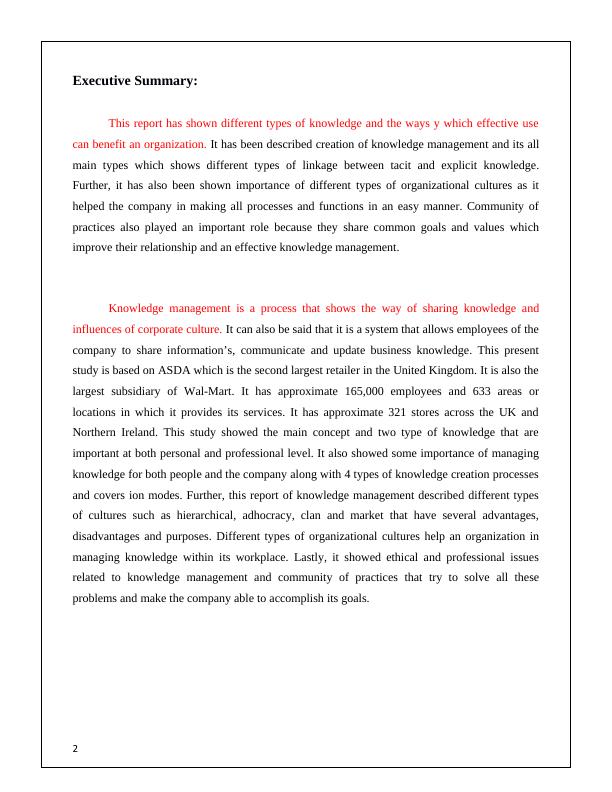
Table of Contents
Executive Summary: ...................................................................................................................................2
SECTION 1....................................................................................................................................................5
1.1 Tacit or Implicit:.................................................................................................................................5
1.2 Explicit knowledge:............................................................................................................................5
1.3 Nonaka's SECI model.........................................................................................................................6
1.4 Criticism of SECI Model......................................................................................................................7
SECTION 2....................................................................................................................................................8
2.1 Cameron and Quinn's core dimensions.............................................................................................8
2.1.1 Individuality and flexibility..............................................................................................................9
2.1.2 Internal maintenance or external positioning..............................................................................10
2.2 Cameron and Quinn's four cultural types........................................................................................11
2.3 Appropriate culture for ASDA..........................................................................................................12
SECTION 3..................................................................................................................................................13
3.1 Organizational benefits of communities of practice........................................................................13
3.2 Team benefits of community of practice.........................................................................................15
3.3 Individual's benefits of community of practices
..............................................................................................................................................................16
3.4 Drawbacks of communities of practice............................................................................................17
Development of knowledge management programs in businesses......................................................18
3
Executive Summary: ...................................................................................................................................2
SECTION 1....................................................................................................................................................5
1.1 Tacit or Implicit:.................................................................................................................................5
1.2 Explicit knowledge:............................................................................................................................5
1.3 Nonaka's SECI model.........................................................................................................................6
1.4 Criticism of SECI Model......................................................................................................................7
SECTION 2....................................................................................................................................................8
2.1 Cameron and Quinn's core dimensions.............................................................................................8
2.1.1 Individuality and flexibility..............................................................................................................9
2.1.2 Internal maintenance or external positioning..............................................................................10
2.2 Cameron and Quinn's four cultural types........................................................................................11
2.3 Appropriate culture for ASDA..........................................................................................................12
SECTION 3..................................................................................................................................................13
3.1 Organizational benefits of communities of practice........................................................................13
3.2 Team benefits of community of practice.........................................................................................15
3.3 Individual's benefits of community of practices
..............................................................................................................................................................16
3.4 Drawbacks of communities of practice............................................................................................17
Development of knowledge management programs in businesses......................................................18
3
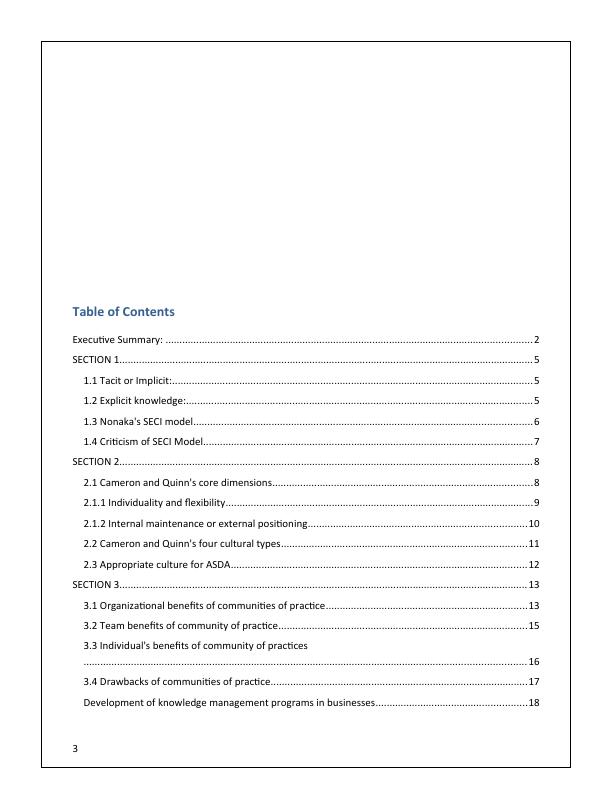
CONCLUSION.............................................................................................................................................19
SECTION 1
Concept of knowledge
Knowledge can be defined as a concept and skills that are being acquired by experience,
education as well as practical understanding of a particular subject (Webb, 2017). Getting
knowledge is not tough but managing that knowledge and skills in an effective manner at both
professional and personal life is quite tough (Kotabe, Casper and Upadhyay, 2017). Effective
knowledge management can make an individual able to accomplish their goals and getting
whatever they want to achieve. So, it is important for people and the manager of ASDA to have
ability to manage knowledge in an efficient manner at all level of its workplace. For more
understanding knowledge it can be understood by its 2 types. There are mainly 23 types of
knowledge which is the key and central of knowledge management such as Tacit and explicit.
1.1 Tacit or Implicit:
Tacit or implicit knowledge refers experimental, subjective and cognitive learning. It is
being gained by experiences and jobs (Garrick and Chan, 2017). Some examples of this type of
knowledge is intuitions and insight that are important to have at workplace. It is personal and
sensitive context. People have to face difficulties in sharing as well as capturing this type of
knowledge. After having difficulties it can also be said that it has high value and a lot of human
interpretation and this is the reason it is hard to document and transfer.
1.2 Explicit knowledge:
This type of knowledge is digitized in documents, books, reports etc. It is a type of
knowledge which can easily be articulated, codified and accessed. This type of knowledge can
also be stored in certain media (Rogers, Revesz and Rebuschat, 2016). It is just opposite of
implicit knowledge because people do not find difficulties in sharing, transferring and
identifying knowledge as it is a type of documented information’s which can be achieved by
anyone. It is easy to share, documented and codify as it is fixed content and structured. It is
4
SECTION 1
Concept of knowledge
Knowledge can be defined as a concept and skills that are being acquired by experience,
education as well as practical understanding of a particular subject (Webb, 2017). Getting
knowledge is not tough but managing that knowledge and skills in an effective manner at both
professional and personal life is quite tough (Kotabe, Casper and Upadhyay, 2017). Effective
knowledge management can make an individual able to accomplish their goals and getting
whatever they want to achieve. So, it is important for people and the manager of ASDA to have
ability to manage knowledge in an efficient manner at all level of its workplace. For more
understanding knowledge it can be understood by its 2 types. There are mainly 23 types of
knowledge which is the key and central of knowledge management such as Tacit and explicit.
1.1 Tacit or Implicit:
Tacit or implicit knowledge refers experimental, subjective and cognitive learning. It is
being gained by experiences and jobs (Garrick and Chan, 2017). Some examples of this type of
knowledge is intuitions and insight that are important to have at workplace. It is personal and
sensitive context. People have to face difficulties in sharing as well as capturing this type of
knowledge. After having difficulties it can also be said that it has high value and a lot of human
interpretation and this is the reason it is hard to document and transfer.
1.2 Explicit knowledge:
This type of knowledge is digitized in documents, books, reports etc. It is a type of
knowledge which can easily be articulated, codified and accessed. This type of knowledge can
also be stored in certain media (Rogers, Revesz and Rebuschat, 2016). It is just opposite of
implicit knowledge because people do not find difficulties in sharing, transferring and
identifying knowledge as it is a type of documented information’s which can be achieved by
anyone. It is easy to share, documented and codify as it is fixed content and structured. It is
4
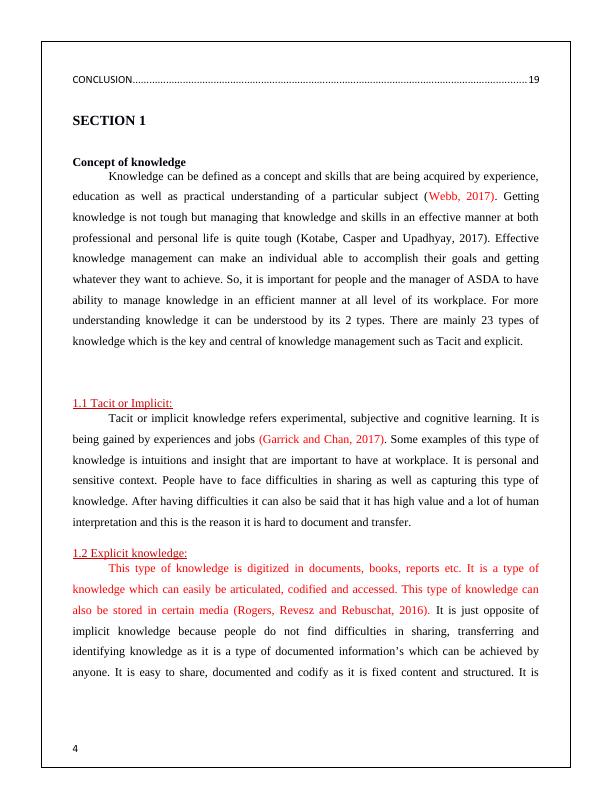
objective, rational and technical. It is written down and accessible so, people find easy to
communicate and store in the context of knowledge management.
So, from the above discussed types of knowledge, it can be understood that knowledge
plays an important role at different level. Both type of knowledge plays a vital role.
1.3 Nonaka's SECI model
It refers a continuous combination, transfer as well as conversion of different kinds of
knowledge. In other words it can also be said that it is a creation and development of new
concepts that occur through making an effective interaction between two type of knowledge such
as tacit and explicit in the mind of people. There are mainly 4 types of knowledge creation
process by which is known as SECI model. It represents and stands for socialization,
externalization, combination and internalization. All these types of knowledge creation are
discussed in detail as below:
Figure 1: SECI model
Socialization: This type of process mainly focuses on making linkage between tacit to
tacit knowledge. New knowledge as per this process can be created by using the process of
interactions, discussing and spending time together while living in the same environment. It is
also a process of making and converting new knowledge via shared experiences (Li, Liu and
Zhou, 2018). In the context of ASDA, it can be said that it gains this type of knowledge by
interacting with its people such as: customers, stakeholders, suppliers etc.
Externalization: It is other and important type of knowledge creation process in which,
company focuses on making link between tacit to explicit knowledge. It is known that tacit
knowledge is achieved by its boundaries and experience so, new knowledge can be created in an
5
communicate and store in the context of knowledge management.
So, from the above discussed types of knowledge, it can be understood that knowledge
plays an important role at different level. Both type of knowledge plays a vital role.
1.3 Nonaka's SECI model
It refers a continuous combination, transfer as well as conversion of different kinds of
knowledge. In other words it can also be said that it is a creation and development of new
concepts that occur through making an effective interaction between two type of knowledge such
as tacit and explicit in the mind of people. There are mainly 4 types of knowledge creation
process by which is known as SECI model. It represents and stands for socialization,
externalization, combination and internalization. All these types of knowledge creation are
discussed in detail as below:
Figure 1: SECI model
Socialization: This type of process mainly focuses on making linkage between tacit to
tacit knowledge. New knowledge as per this process can be created by using the process of
interactions, discussing and spending time together while living in the same environment. It is
also a process of making and converting new knowledge via shared experiences (Li, Liu and
Zhou, 2018). In the context of ASDA, it can be said that it gains this type of knowledge by
interacting with its people such as: customers, stakeholders, suppliers etc.
Externalization: It is other and important type of knowledge creation process in which,
company focuses on making link between tacit to explicit knowledge. It is known that tacit
knowledge is achieved by its boundaries and experience so, new knowledge can be created in an
5
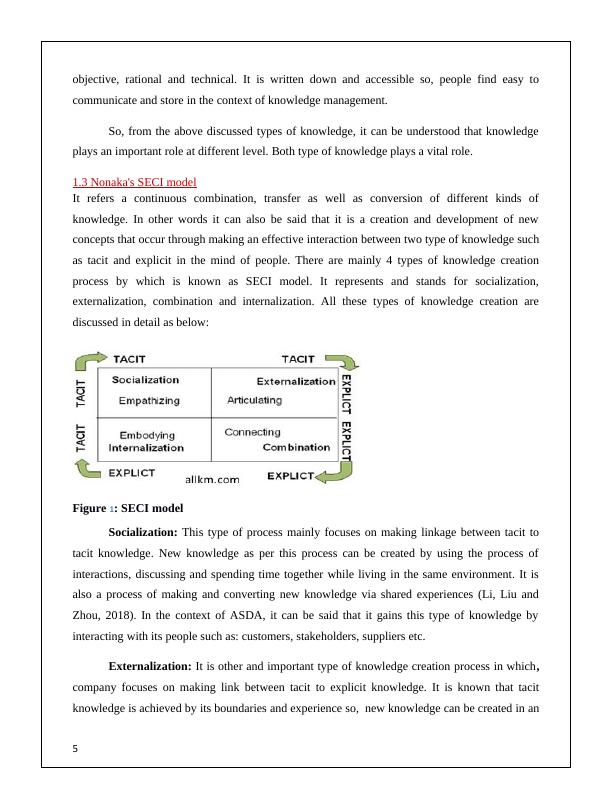
efficient manner. The process of externalization is often driven by metaphor analogy and
models. Employees of ASDA make a linkage between their learning and experienced for making
a new knowledge and making working environment more innovative. It helps them out in
solving critical problems which they were trying to solve for providing better services to
customers.
Combination: It is other process in which company and people focuses on making a new
knowledge by making an effective link between explicit to explicit knowledge. In this type,
financial department of ASDA collect all necessary financial reports and information’s from
each department of the company and publics a consolidated annual financial performance
report . For getting business report, there is a requirement to make a creative use and
combination of some element and functions such as: adding, sorting and categorizing (Nonaka
and Toyama, 2015).
Internalization: In this type, company focuses on creating explicit knowledge by
making an effective use of tacit knowledge as well as sharing it to all departments and areas of
the company. It is stated that when employees read this tacit knowledge then it spread an area of
learning spiral of knowledge creation (Knowledge management System, 2019). When this type
of knowledge is socialization then ASDA tries to innovate and learn this knowledge. For
internalizing this tacit knowledge by employees of the company, ASDA provides effective
training to them. It makes all employees more able to internalize tacit knowledge after the
process of internalization.
So, from the above it can be said that the best process of knowledge creation is
externalization because in this type, knowledge become permanent as well as easier to share with
others.
1.4 Criticism of SECI Model
There are some limitations and criticism of Nonaka's SECI model of organizational
knowledge creation that has recently been described as a highly respected theory.
It is stated about this theory that it cannot explain the ways how mind produce ideas.
There is no description and detail about the way which can tell that how it can be
managed.
6
models. Employees of ASDA make a linkage between their learning and experienced for making
a new knowledge and making working environment more innovative. It helps them out in
solving critical problems which they were trying to solve for providing better services to
customers.
Combination: It is other process in which company and people focuses on making a new
knowledge by making an effective link between explicit to explicit knowledge. In this type,
financial department of ASDA collect all necessary financial reports and information’s from
each department of the company and publics a consolidated annual financial performance
report . For getting business report, there is a requirement to make a creative use and
combination of some element and functions such as: adding, sorting and categorizing (Nonaka
and Toyama, 2015).
Internalization: In this type, company focuses on creating explicit knowledge by
making an effective use of tacit knowledge as well as sharing it to all departments and areas of
the company. It is stated that when employees read this tacit knowledge then it spread an area of
learning spiral of knowledge creation (Knowledge management System, 2019). When this type
of knowledge is socialization then ASDA tries to innovate and learn this knowledge. For
internalizing this tacit knowledge by employees of the company, ASDA provides effective
training to them. It makes all employees more able to internalize tacit knowledge after the
process of internalization.
So, from the above it can be said that the best process of knowledge creation is
externalization because in this type, knowledge become permanent as well as easier to share with
others.
1.4 Criticism of SECI Model
There are some limitations and criticism of Nonaka's SECI model of organizational
knowledge creation that has recently been described as a highly respected theory.
It is stated about this theory that it cannot explain the ways how mind produce ideas.
There is no description and detail about the way which can tell that how it can be
managed.
6
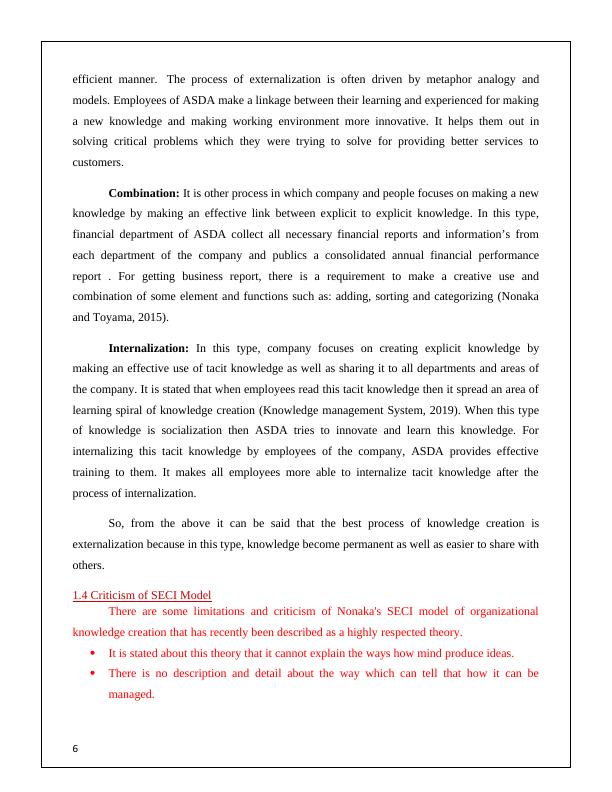
End of preview
Want to access all the pages? Upload your documents or become a member.
Related Documents
Managing Knowledge: Concepts, Models, and Culturelg...
|15
|4857
|1
Managing Knowledge: Nonaka's Concept of Knowledge and Cameron and Quinn Competing Values Culture Modellg...
|15
|4936
|61
Managing Knowledgelg...
|15
|5022
|92
Managing Knowledgelg...
|18
|5274
|82
Managing Knowledge: Importance, SECI Model, and Cultural Modelslg...
|14
|4844
|3
Managing Knowledgelg...
|16
|5401
|212
